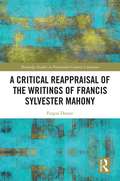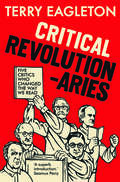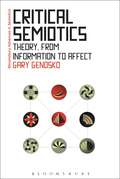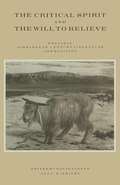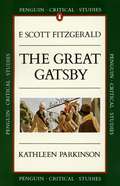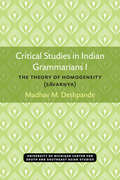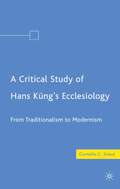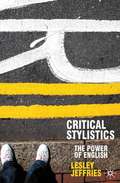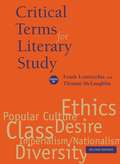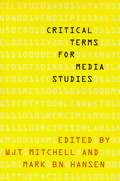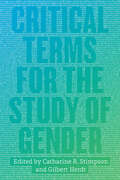- Table View
- List View
A Critical Reappraisal of the Writings of Francis Sylvester Mahony (Routledge Studies in Nineteenth Century Literature)
by Fergus DunneThis book resituates Francis Sylvester Mahony in an early nineteenth-century literary-historical context, counteracting the efforts of twentieth-century literary historians to obscure his contribution to the emergence of a distinctive Irish Catholic fiction in English. This volume re-explores his ambivalent role as a Catholic unionist contributor to the progressive Tory London periodical, Fraser’s Magazine, examining his use of translation to map out an alternative literary aesthetic of the peripheries. The book also traces the development of his political thinking in his Italian journalism for Charles Dickens’ Daily News, in which he responded to the events of the Famine by finding common cause with Young Ireland, and looks afresh at his final incarnation as a British Liberal commentator on Irish and European affairs for the Globe newspaper. More broadly, the book seeks to re-evaluate Mahony’s cosmopolitan writings in relation to the multifaceted, transnational perspectives on Irish, British, and European affairs presented in his essays and journalism.
Critical Revolutionaries: Five Critics Who Changed the Way We Read
by Terry EagletonTerry Eagleton looks back across sixty years to an extraordinary critical milieu that transformed the study of literature Before the First World War, traditional literary scholarship was isolated from society at large. In the years following, a younger generation of critics came to the fore. Their work represented a reaction to the impoverishment of language in a commercial, utilitarian society increasingly under the sway of film, advertising, and the popular press. For them, literary criticism was a way of diagnosing social ills and had a vital moral function to perform. Terry Eagleton reflects on the lives and work of T. S. Eliot, I. A. Richards, William Empson, F. R. Leavis, and Raymond Williams, and explores a vital tradition of literary criticism that today is in danger of being neglected. These five critics rank among the most original and influential of modern times, and represent one of the most remarkable intellectual formations in twentieth-century Britain. This was the heyday of literary modernism, a period of change and experimentation—the bravura of which spurred on developments in critical theory.
Critical Semiotics: Theory, from Information to Affect (Bloomsbury Advances in Semiotics)
by Gary GenoskoCritical Semiotics provides long overdue answers to questions at the junction of information, meaning and 'affect'. The affective turn in cultural studies has received much attention: a focus on the pre-individual bodily forces, linked to automatic responses, which augment or diminish the body's capacity to act or engage with others. In a world dominated by information, how do things that seem to have diminished meaning or even no meaning still have so much power to affect us, or to carry on our ability to affect the world?Linguistics and semiotics have been accused of being adrift from the affective turn and not accounting for these visceral forces beneath or generally other from conscious knowing. In this book, Gary Genosko delivers a detailed refutation, with analyses of specific contributions to critical semiotic approaches to meaning and signification. People want to understand how other people are moved and to understand embodied social actions, feelings and passions at the same time as understanding how this takes place. Semiotics must make the affective turn.
Critical Semiotics: Theory, from Information to Affect (Bloomsbury Advances in Semiotics)
by Gary GenoskoCritical Semiotics provides long overdue answers to questions at the junction of information, meaning and 'affect'. The affective turn in cultural studies has received much attention: a focus on the pre-individual bodily forces, linked to automatic responses, which augment or diminish the body's capacity to act or engage with others. In a world dominated by information, how do things that seem to have diminished meaning or even no meaning still have so much power to affect us, or to carry on our ability to affect the world?Linguistics and semiotics have been accused of being adrift from the affective turn and not accounting for these visceral forces beneath or generally other from conscious knowing. In this book, Gary Genosko delivers a detailed refutation, with analyses of specific contributions to critical semiotic approaches to meaning and signification. People want to understand how other people are moved and to understand embodied social actions, feelings and passions at the same time as understanding how this takes place. Semiotics must make the affective turn.
Critical Sexuality Studies, Lavender Languages, and Everyday Life (Advances in Sociolinguistics)
by Michelle Marzullo and William L. LeapCritical Sexuality Studies (CSS) and Lavender Languages/Linguistics (LLL) are leading modes of inquiry in two different fields of sexuality studies. In this edited collection, chapters reveal how these can be combined to produce a new approach to analyzing language use, sexuality and gender, and discourse on authority and power. The book demonstrates how together LLL and CSS iterate each other through their mutual concern with sexuality, gender, and power, especially when considering the materiality of daily life. Authors then compare CSS to other fields of sexuality studies to reveal commonalities and tensions that are addressed via the LLL-based interventions exemplified in this volume. The body of the book organizes examples of Lavender Languages projects around a four-part CSS framework, with an introductory essay for each section indicating the connections between the CSS theme and the LLL examples. The volume concludes with reflections showing how CSS interests in sexuality and power benefits from LLL with its emphasis on socially focused studies of discourse and text. Strengthening pathways to future knowledge-making, this book provides a detailed roadmap for scholarly and activist engagements in language-centered critical sexuality studies.
Critical Sexuality Studies, Lavender Languages, and Everyday Life (Advances in Sociolinguistics)
Critical Sexuality Studies (CSS) and Lavender Languages/Linguistics (LLL) are leading modes of inquiry in two different fields of sexuality studies. In this edited collection, chapters reveal how these can be combined to produce a new approach to analyzing language use, sexuality and gender, and discourse on authority and power. The book demonstrates how together LLL and CSS iterate each other through their mutual concern with sexuality, gender, and power, especially when considering the materiality of daily life. Authors then compare CSS to other fields of sexuality studies to reveal commonalities and tensions that are addressed via the LLL-based interventions exemplified in this volume. The body of the book organizes examples of Lavender Languages projects around a four-part CSS framework, with an introductory essay for each section indicating the connections between the CSS theme and the LLL examples. The volume concludes with reflections showing how CSS interests in sexuality and power benefits from LLL with its emphasis on socially focused studies of discourse and text. Strengthening pathways to future knowledge-making, this book provides a detailed roadmap for scholarly and activist engagements in language-centered critical sexuality studies.
Critical Sociolinguistic Research Methods: Studying Language Issues That Matter
by Monica Heller Sari Pietikäinen Joan PujolarCritical Sociolinguistic Research Methods is a guide to conducting concrete ethnographic and discourse analytic research projects, written by top scholars for students and researchers in social science fields. Adopting a critical perspective focusing on the role of language in the construction of social difference and social inequality, the authors walk the reader through five key moments in the life of a research project: composing research questions, designing the project, doing fieldwork, performing data analysis and writing academic texts or otherwise engaging in conversation with different types of social actors about the project. These moments are illustrated by colour-coded examples from the authors’ experiences that help researchers and students follow the sequential stages of a project. Clear and highly applicable, with a detailed workbook full of practical tips and examples, this book is a great resource for graduate-level qualitative methods courses in linguistics and anthropology, as well as methods courses in the humanities and social sciences that focus on the role of language in research. It is a timely text for investigating language issues that matter and have consequences for people’s lives.
Critical Sociolinguistic Research Methods: Studying Language Issues That Matter
by Monica Heller Sari Pietikäinen Joan PujolarCritical Sociolinguistic Research Methods is a guide to conducting concrete ethnographic and discourse analytic research projects, written by top scholars for students and researchers in social science fields. Adopting a critical perspective focusing on the role of language in the construction of social difference and social inequality, the authors walk the reader through five key moments in the life of a research project: composing research questions, designing the project, doing fieldwork, performing data analysis and writing academic texts or otherwise engaging in conversation with different types of social actors about the project. These moments are illustrated by colour-coded examples from the authors’ experiences that help researchers and students follow the sequential stages of a project. Clear and highly applicable, with a detailed workbook full of practical tips and examples, this book is a great resource for graduate-level qualitative methods courses in linguistics and anthropology, as well as methods courses in the humanities and social sciences that focus on the role of language in research. It is a timely text for investigating language issues that matter and have consequences for people’s lives.
Critical Sociolinguistic Research Methods: Studying Language Issues That Matter
by Sari Pietikäinen Monica Heller Joan PujolarCritical Sociolinguistic Research Methods is a guide to conducting concrete ethnographic and discourse analytic research projects, written by top scholars for students and researchers in social science fields. Adopting a critical perspective focusing on the role of language in the construction of social difference and social inequality, the authors walk the reader through five key moments in the life of a research project: composing research questions, designing the project, doing fieldwork, performing data analysis and writing academic texts or otherwise engaging in conversation with different types of social actors about the project. These moments are illustrated by colour-coded examples from the authors’ experiences that help researchers and students follow the sequential stages of a project.Now in its second edition, this popular and original text has been revised and updated to reflect the latest developments in this field, including expanded sections on the centrality of the ethnographic gaze for the understanding of social processes, and on experiences of diversification in the communication of research results. Through the adoption of multimodal genres, authors share recent experiences of research presentations addressed to non-academic audiences, such as installations and photography, and interactive maps.Clear and highly applicable, with a detailed workbook full of practical tips and examples, this book is a great resource for graduate-level qualitative methods courses in linguistics and anthropology, as well as methods courses in the humanities and social sciences that focus on the role of language in research. It is a timely text for investigating language issues that matter and have consequences for people’s lives.
Critical Sociolinguistics: Dialogues, Dissonances, Developments (Advances in Sociolinguistics)
by Alfonso Del Percio and Mi-Cha FlubacherProviding a series of crucial debates on language, power, difference and social inequality, this volume traces developments and dissonances in critical sociolinguistics. Eminent and emerging academic figures from around the world collaboratively engage with the work of Monica Heller, offering insights into the politics and power formations that surround knowledge of language and society. Challenging disciplinary power dynamics in critical sociolinguistics, this book is an experiment testing new ways of producing knowledge on language and society. Critically discussing central sociolinguistic concepts from critique to political economy, labor to media, education to capitalism, each chapter features a number of scholars offering their distinct social and political perspectives on the place played by language in the social fabric. Through its theoretical, epistemological, and methodological breadth, the volume foregrounds political alliances in how language is known and explored by scholars writing from specific geopolitical spaces that come with diverse political struggles and dynamics of power. Allowing for a diversity of genres, debates, controversies, fragments and programmatic manifestos, the volume prefigures a new mode of knowledge production that multiplies perspectives and starts practicing the more inclusive, just and equal worlds that critical sociolinguists envision.
Critical Sociolinguistics: Dialogues, Dissonances, Developments (Advances in Sociolinguistics)
Providing a series of crucial debates on language, power, difference and social inequality, this volume traces developments and dissonances in critical sociolinguistics. Eminent and emerging academic figures from around the world collaboratively engage with the work of Monica Heller, offering insights into the politics and power formations that surround knowledge of language and society. Challenging disciplinary power dynamics in critical sociolinguistics, this book is an experiment testing new ways of producing knowledge on language and society. Critically discussing central sociolinguistic concepts from critique to political economy, labor to media, education to capitalism, each chapter features a number of scholars offering their distinct social and political perspectives on the place played by language in the social fabric. Through its theoretical, epistemological, and methodological breadth, the volume foregrounds political alliances in how language is known and explored by scholars writing from specific geopolitical spaces that come with diverse political struggles and dynamics of power. Allowing for a diversity of genres, debates, controversies, fragments and programmatic manifestos, the volume prefigures a new mode of knowledge production that multiplies perspectives and starts practicing the more inclusive, just and equal worlds that critical sociolinguists envision.
The Critical Spirit and the Will to Believe: Essays in Nineteenth-Century Literature and Religion (pdf)
by D. Jasper Sharon McGuire T R WrightCritical Studies: The Great Gatsby (The Great Gatsby)
by Kathleen ParkinsonKathleen Parkinson places this brilliant and bitter satire on the moral failure of the Jazz Age firmly in the context of Scott Fitzgerald's life and times. She explores the intricate patterns of the novel, its chronology, locations, imagery and use of colour, and how these contribute to a seamless interplay of social comedy and symbolic landscape. She devotes a perceptive chapter to Fitzgerald's controversial portrayal of women and goes on to discuss how the central characters, Gatsby and Nick Carraway, embody and confront the dualism inherent in the American dream.
Critical Studies in Indian Grammarians I: The Theory of Homogeneity (Savar?ya) (Michigan Series In South And Southeast Asian Languages And Linguistics)
by Madhav M. DeshpandeIn the historical study of the Indian grammarian tradition, a line of demarcation can often be drawn between the conformity of a system with the well-known grammar of Pa?ini and the explanatory effectiveness of that system. One element of Pa?ini’s grammar that scholars have sometimes struggled to bring across this line of demarcation is the theory of homogeneity, or savar?ya, which concerns the final consonants in Pa?ini’s reference catalog, as well as phonetic similarities between sounds. While modern Sanskrit scholars understand how to interpret and apply Pa?ini’s homogeneity, they still find it necessary to unravel the history of varying interpretations of the theory in subsequent grammars. Madhav Deshpande’s The Theory of Homogeneity provides a thorough account of the historical development of the theory. Proceeding first to study this conception in the Pa?inian tradition, Deshpande then passes on to other grammatical systems. Deshpande gives attention not only to the definitions of homogeneity in these systems but also the implementation of the theory in those respective systems. Even where definitions are identical, the concept may be applied quite differently, in which cases Deshpande examines by considering the historical relationships among the various systems.
A Critical Study of Hans Küng’s Ecclesiology: From Traditionalism to Modernism
by C. SimutThe book presents the transition from traditionalism to modernism in connection to two of Küng's most important books on ecclesiology: Structures of the Church (1962) as representing Küng's traditional theology, and On Being a Christian (1974) as a reflection of his modern approach to Christianity.
Critical Stylistics: The Power Of English (PDF)
by Lesley JeffriesWe tend to think that politicians, copywriters and journalists can affect us by their use of language, but how does this happen, exactly? Critical Discourse Analysis provides us with general theories for explaining the impact texts can have, considering the social and political contexts in which texts are produced and read. Stylistics provides detailed tools of analysis for understanding how texts work. Critical Stylistics combines the strengths of these two approaches to uncover the deep-seated ideologies of everyday texts. Original and engaging,Critical Stylistics: * presents a new amalgamation of stylistics, critical discourse analysis and functional approaches to grammar * introduces a comprehensive set of tools to help explain and analyse the power of written texts * examines a wide variety of real texts and provides a wealth of practical worked examples
Critical Stylistics: The Power of English (Perspectives on the English Language)
by Lesley JeffriesThis original and engaging textbook is concerned with stylistic choices, and the textual analysis which can illuminate the choices that a text producer has made. It combines the strengths of two approaches – critical discourse analysis and stylistics – to uncover the deep-seated ideologies of everyday texts. In so doing, it introduces a comprehensive set of tools which will help readers to explain and analyse the power of written texts. Each chapter focuses on a particular linguistic feature – such as naming and describing, prioritizing, negating, and hypothesizing – gives an overview of its argument and then explains the technical aspects of the feature along with a wealth of examples.This book will be ideal reading for students on a wide range of courses, including stylistics, discourse analysis, critical discourse analysis, English functional grammar and advanced composition.
Critical Terms for Literary Study, Second Edition (Critical Terms)
by Lentricchia, Frank and McLaughlin, ThomasSince its publication in 1990, Critical Terms for Literary Study has become a landmark introduction to the work of literary theory—giving tens of thousands of students an unparalleled encounter with what it means to do theory and criticism. Significantly expanded, this new edition features six new chapters that confront, in different ways, the growing understanding of literary works as cultural practices. These six new chapters are "Popular Culture," "Diversity," "Imperialism/Nationalism," "Desire," "Ethics," and "Class," by John Fiske, Louis Menand, Seamus Deane, Judith Butler, Geoffrey Galt Harpham, and Daniel T. O'Hara, respectively. Each new essay adopts the approach that has won this book such widespread acclaim: each provides a concise history of a literary term, critically explores the issues and questions the term raises, and then puts theory into practice by showing the reading strategies the term permits. Exploring the concepts that shape the way we read, the essays combine to provide an extraordinary introduction to the work of literature and literary study, as the nation's most distinguished scholars put the tools of critical practice vividly to use.
Critical Terms for Media Studies (Critical Terms)
by W. J. T. Mitchell Mark B. N. HansenCommunications, philosophy, film and video, digital culture: media studies straddles an astounding array of fields and disciplines and produces a vocabulary that is in equal parts rigorous and intuitive. Critical Terms for Media Studies defines, and at times, redefines, what this new and hybrid area aims to do, illuminating the key concepts behind its liveliest debates and most dynamic topics. Part of a larger conversation that engages culture, technology, and politics, this exciting collection of essays explores our most critical language for dealing with the qualities and modes of contemporary media. Edited by two outstanding scholars in the field, W. J. T. Mitchell and Mark B. N. Hansen, the volume features works by a team of distinguished contributors. These essays, commissioned expressly for this volume, are organized into three interrelated groups: “Aesthetics” engages with terms that describe sensory experiences and judgments, “Technology” offers entry into a broad array of technological concepts, and “Society” opens up language describing the systems that allow a medium to function. A compelling reference work for the twenty-first century and the media that form our experience within it, Critical Terms for Media Studies will engage and deepen any reader’s knowledge of one of our most important new fields.
Critical Terms for Media Studies (Critical Terms)
by W. J. T. Mitchell Mark B. N. HansenCommunications, philosophy, film and video, digital culture: media studies straddles an astounding array of fields and disciplines and produces a vocabulary that is in equal parts rigorous and intuitive. Critical Terms for Media Studies defines, and at times, redefines, what this new and hybrid area aims to do, illuminating the key concepts behind its liveliest debates and most dynamic topics. Part of a larger conversation that engages culture, technology, and politics, this exciting collection of essays explores our most critical language for dealing with the qualities and modes of contemporary media. Edited by two outstanding scholars in the field, W. J. T. Mitchell and Mark B. N. Hansen, the volume features works by a team of distinguished contributors. These essays, commissioned expressly for this volume, are organized into three interrelated groups: “Aesthetics” engages with terms that describe sensory experiences and judgments, “Technology” offers entry into a broad array of technological concepts, and “Society” opens up language describing the systems that allow a medium to function. A compelling reference work for the twenty-first century and the media that form our experience within it, Critical Terms for Media Studies will engage and deepen any reader’s knowledge of one of our most important new fields.
Critical Terms for Media Studies (Critical Terms)
by W. J. T. Mitchell Mark B. N. HansenCommunications, philosophy, film and video, digital culture: media studies straddles an astounding array of fields and disciplines and produces a vocabulary that is in equal parts rigorous and intuitive. Critical Terms for Media Studies defines, and at times, redefines, what this new and hybrid area aims to do, illuminating the key concepts behind its liveliest debates and most dynamic topics. Part of a larger conversation that engages culture, technology, and politics, this exciting collection of essays explores our most critical language for dealing with the qualities and modes of contemporary media. Edited by two outstanding scholars in the field, W. J. T. Mitchell and Mark B. N. Hansen, the volume features works by a team of distinguished contributors. These essays, commissioned expressly for this volume, are organized into three interrelated groups: “Aesthetics” engages with terms that describe sensory experiences and judgments, “Technology” offers entry into a broad array of technological concepts, and “Society” opens up language describing the systems that allow a medium to function. A compelling reference work for the twenty-first century and the media that form our experience within it, Critical Terms for Media Studies will engage and deepen any reader’s knowledge of one of our most important new fields.
Critical Terms for the Study of Gender (Critical Terms)
by Catharine R. Stimpson and Gilbert Herdt“Gender systems pervade and regulate human lives—in law courts and operating rooms, ballparks and poker clubs, hair-dressing salons and kitchens, classrooms and playgroups. . . . Exactly how gender works varies from culture to culture, and from historical period to historical period, but gender is very rarely not at work. Nor does gender operate in isolation. It is linked to other social structures and sources of identity.” So write women’s studies pioneer Catharine R. Stimpson and anthropologist Gilbert Herdt in their introduction to Critical Terms for the Study of Gender, laying out the wide-ranging nature of this interdisciplinary and rapidly changing field. The sixth in the series of “Critical Terms” books, this volume provides an indispensable introduction to the study of gender through an exploration of key terms that are a part of everyday discourse in this vital subject. Following Stimpson and Herdt’s careful account of the evolution of gender studies and its relation to women’s and sexuality studies, the twenty-one essays here cast an appropriately broad net, spanning the study of gender and sexuality across the humanities and social sciences. Written by a distinguished group of scholars, each essay presents students with a history of a given term—from bodies to utopia—and explains the conceptual baggage it carries and the kinds of critical work it can be made to do. The contributors offer incisive discussions of topics ranging from desire, identity, justice, and kinship to love, race, and religion that suggest new directions for the understanding of gender studies. The result is an essential reference addressed to students studying gender in very different disciplinary contexts.
Critical Terms for the Study of Gender (Critical Terms)
by Catharine R. Stimpson and Gilbert Herdt“Gender systems pervade and regulate human lives—in law courts and operating rooms, ballparks and poker clubs, hair-dressing salons and kitchens, classrooms and playgroups. . . . Exactly how gender works varies from culture to culture, and from historical period to historical period, but gender is very rarely not at work. Nor does gender operate in isolation. It is linked to other social structures and sources of identity.” So write women’s studies pioneer Catharine R. Stimpson and anthropologist Gilbert Herdt in their introduction to Critical Terms for the Study of Gender, laying out the wide-ranging nature of this interdisciplinary and rapidly changing field. The sixth in the series of “Critical Terms” books, this volume provides an indispensable introduction to the study of gender through an exploration of key terms that are a part of everyday discourse in this vital subject. Following Stimpson and Herdt’s careful account of the evolution of gender studies and its relation to women’s and sexuality studies, the twenty-one essays here cast an appropriately broad net, spanning the study of gender and sexuality across the humanities and social sciences. Written by a distinguished group of scholars, each essay presents students with a history of a given term—from bodies to utopia—and explains the conceptual baggage it carries and the kinds of critical work it can be made to do. The contributors offer incisive discussions of topics ranging from desire, identity, justice, and kinship to love, race, and religion that suggest new directions for the understanding of gender studies. The result is an essential reference addressed to students studying gender in very different disciplinary contexts.
Critical Terms for the Study of Gender (Critical Terms)
by Catharine R. Stimpson and Gilbert Herdt“Gender systems pervade and regulate human lives—in law courts and operating rooms, ballparks and poker clubs, hair-dressing salons and kitchens, classrooms and playgroups. . . . Exactly how gender works varies from culture to culture, and from historical period to historical period, but gender is very rarely not at work. Nor does gender operate in isolation. It is linked to other social structures and sources of identity.” So write women’s studies pioneer Catharine R. Stimpson and anthropologist Gilbert Herdt in their introduction to Critical Terms for the Study of Gender, laying out the wide-ranging nature of this interdisciplinary and rapidly changing field. The sixth in the series of “Critical Terms” books, this volume provides an indispensable introduction to the study of gender through an exploration of key terms that are a part of everyday discourse in this vital subject. Following Stimpson and Herdt’s careful account of the evolution of gender studies and its relation to women’s and sexuality studies, the twenty-one essays here cast an appropriately broad net, spanning the study of gender and sexuality across the humanities and social sciences. Written by a distinguished group of scholars, each essay presents students with a history of a given term—from bodies to utopia—and explains the conceptual baggage it carries and the kinds of critical work it can be made to do. The contributors offer incisive discussions of topics ranging from desire, identity, justice, and kinship to love, race, and religion that suggest new directions for the understanding of gender studies. The result is an essential reference addressed to students studying gender in very different disciplinary contexts.
Critical Terms for the Study of Gender (Critical Terms)
by Catharine R. Stimpson Gilbert Herdt“Gender systems pervade and regulate human lives—in law courts and operating rooms, ballparks and poker clubs, hair-dressing salons and kitchens, classrooms and playgroups. . . . Exactly how gender works varies from culture to culture, and from historical period to historical period, but gender is very rarely not at work. Nor does gender operate in isolation. It is linked to other social structures and sources of identity.” So write women’s studies pioneer Catharine R. Stimpson and anthropologist Gilbert Herdt in their introduction to Critical Terms for the Study of Gender, laying out the wide-ranging nature of this interdisciplinary and rapidly changing field. The sixth in the series of “Critical Terms” books, this volume provides an indispensable introduction to the study of gender through an exploration of key terms that are a part of everyday discourse in this vital subject. Following Stimpson and Herdt’s careful account of the evolution of gender studies and its relation to women’s and sexuality studies, the twenty-one essays here cast an appropriately broad net, spanning the study of gender and sexuality across the humanities and social sciences. Written by a distinguished group of scholars, each essay presents students with a history of a given term—from bodies to utopia—and explains the conceptual baggage it carries and the kinds of critical work it can be made to do. The contributors offer incisive discussions of topics ranging from desire, identity, justice, and kinship to love, race, and religion that suggest new directions for the understanding of gender studies. The result is an essential reference addressed to students studying gender in very different disciplinary contexts.
